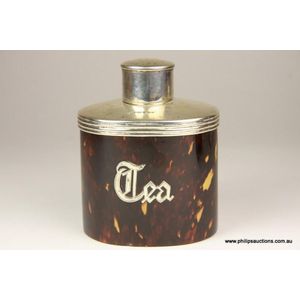Sterling Silver and Tortoiseshell Tea Caddy, 1894 Chester
A sterling silver and tortoiseshell tea caddy, 1894 Chester, with maker's marks for Cornelius Desormeaux Saunders & James Francis Hollings (Frank) shepherd, an oval straight sided caddy of tortoiseshell with a silver mount having a simple ribbed design to the collar and a lift off lid with an engine turned band, the word 'Tea' in silver script applied to the side; foil lined and with a leather base; hallmarked to mount and lid, total weight 141gr. Height 11.5 cm
You must be a subscriber, and be logged in to view price and dealer details.
Subscribe Now to view actual auction price for this item
When you subscribe, you have the option of setting the currency in which to display prices to $Au, $US, $NZ or Stg.
This item has been sold, and the description, image and price are for reference purposes only.
- Tortoiseshell - Tortoiseshell is a translucent material that comes from the horny carapace of a certain types of turtles, including the hawksbill turtle. It is often therefore mounted on a colour underground - often red - or inlaid with gold or silver thread, as seen in Boulle furniture.
The texture and colour nuances of the material are extremely important. Heated tortoiseshell can easily be formed into various shapes. Like other natural materials, tortoiseshell becomes more beautiful with use. In a time before plastic, tortoiseshell was widely used for small objects such as combs and powder compacts.
In 1973, the trade of tortoiseshell worldwide was banned under CITES (The Convention on International Trade in Endangered Species). Prior to importing or exporting items containing tortoiseshell a CITES permit must be obtained. Tortoiseshell items cannot be traded on Ebay.
"Faux tortoiseshell", another case of man initiating nature, is made from old-style plastics such as celluloid and cellulos and is coloured with red, yellow and brown spots to imitate the genuine article. It is commonly used in glasses frames, musical instruments and costume jewellery. - Sterling Silver - Sterling silver is a mixture of 92.5% pure silver and 7.5% of another metal, usually copper. Fine silver is 99.9% pure silver, and is relatively soft and the addition of the very small amount of copper gives the metal enough strength and hardness to be worked into jewellery, decorative and household objects.
- Engine Turned - Engine turning is a decorative technique used on metal surfaces to create intricate curving or geometric pattern. The process involves cutting a series of lines into the surface of the metal using a rose engine or decoration lathe which rotates the metal as it cuts, allowing the operator to create a repeating pattern that covers the entire surface. The resulting surface has a shimmering, reflective quality that is often described as "engine turned." Where an engine turned item has been enamelled, the term used to describe the decoration is usually guilloche.
Engine turning was originally developed to decorate metal objects such as firearms, scientific instruments, and other metal objects that required precise and elegant design.
This item has been included into following indexes:
Visually similar items

Art Nouveau sterling silver tea caddy cylindrical shape with detachable lid, stylised Art Nouveau floral panels, Sheffield, 1901, maker Roberts & Belk limited
Sold by
in
for
You can display prices in $Au, $US, $NZ or Stg.

A pair of English silver-plate hip flasks
Sold by
in
for
You can display prices in $Au, $US, $NZ or Stg.

Antique silver plate tea caddy, crested with stag, marked William Hutton, 11 cm high
Sold by
in
for
You can display prices in $Au, $US, $NZ or Stg.

A Victorian silver tea caddy. Worn marks. Chester, 1900. 99gm
Sold by
in
for
You can display prices in $Au, $US, $NZ or Stg.
